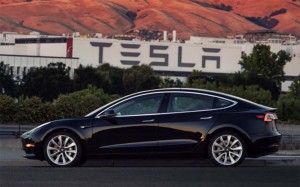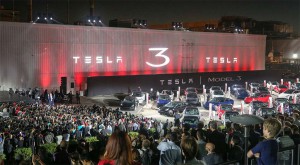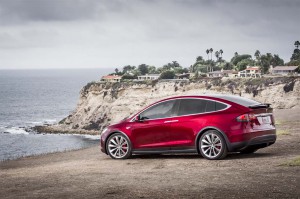Aiming for a massive increase in production to meet strong demand for its new Model 3 battery-electric vehicle, Tesla is issuing $1.5 billion in high-yield junk bonds.
The announced comes less than a week after Tesla said it had narrowed its losses for the second quarter. During a conference call to discuss the earnings report, CEO Elon Musk indicated the automaker might need a new cash infusion but would try to avoid issuing new stock.
The new debt offering is meant “to further strengthen its balance sheet during this period of rapid scaling with the launch of Model 3, and for general corporate purposes.”
(For more on Tesla’s Q2 earnings, Click Here.)
Tesla has gone to the well several times to fund the development and production of the Model 3, its first mainstream-priced offering. That included a stock offering in May 2016. Despite having a stock price that hit record levels in June, and a current market capitalization of around $58 billion – making it the highest-valued U.S. automaker – Tesla has been straining its cash resources, the company ending the April-June quarter with just $3 billion on hand.
Without new capital, analysts have warned that this would pose challenges for Tesla’s plan to boost production almost eightfold from 2016 to 2018 — reaching Musk’s target of 10,000 vehicles a week by late next year. The vast majority of those will be the new Model 3.
According to the CEO, Tesla has received about 460,000 advance reservations, complete with $1,000 deposits, since the Model 3 was unveiled on March 31, 2016. Many are now being converted to actual orders, while new customers are signing up at a rate of about 2,000 a week, he said. Even if Tesla were to meet Musk’s ambitious production ramp-up plans, however, he warned that it would be late next year, at the earliest, all current orders would be met.
“This is probably the best I’ve ever felt about the company,” Musk said on August 2nd, despite the fact that Tesla remained in the red for the April-June period. Tesla has posted deficits for all but two quarters since going public.
But getting the company’s Fremont, California plant up to speed won’t come easy – Musk last month triggering a sharp drop in Tesla’s stock price when he warned that the next six months will bring “manufacturing hell” at the plant.
And it won’t come cheap, Tesla planning $2 billion on capital expenditures during the second half of this year, a 33% increase from the first half. Meanwhile, Tesla is also investing in the development of new products to come, including a heavy-duty electric truck set to be revealed in September, a battery-electric pickup, an all-new version of its original Roadster model, and a compact electric SUV to be called the Model Y.
(Chevy Bolt EV delivers better range than Model S, says Consumer Reports. Click Here for more.)
Adding to the cost of product development, Tesla has decided to base the Model Y on its own platform, rather than sharing the architecture of the Model 3. That runs counter to current industry wisdom which has manufacturers aiming to maximize commonality between different product lines.
The first saleable version of the new Model 3 was launched last month, followed by a splashy event 10 days ago in which the first 30 of the sedans were handed off to customers. One of the big questions is whether the Model 3 – and the Model Y to follow – will cannibalize sales of Tesla’s older product lines. The Model S carries a starting price about twice that of the Model 3 – though Musk revealed last month that the early versions of the new sedan will run about $44,000. The base, $35,000 Model 3 won’t be added to the production run until autumn.
(Click Here for more about the delivery of the first 30 Tesla Model 3 sedans.)
It may help Tesla keep a balance on demand with news that it is cutting the price of the Model X by $3,000, to $79,500. That said, a fully loaded version with the maximum range battery pack, the P100D, will still run $145,000.
“When we launched Model X 75D, it had a low gross margin. As we’ve achieved efficiencies, we are able to lower the price and pass along more value to our customers,” Tesla in a statement.




Do I smell more government subsidies ?
Completely unlikely.
Product development, sustained product cadence, ongoing marketing cost, California labor issues, after sales parts and service issues, etc, etc, etc. Good luck with all of that.
Oh, did I forget competition from the most competitive industry on the planet!